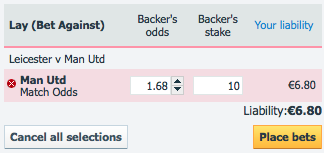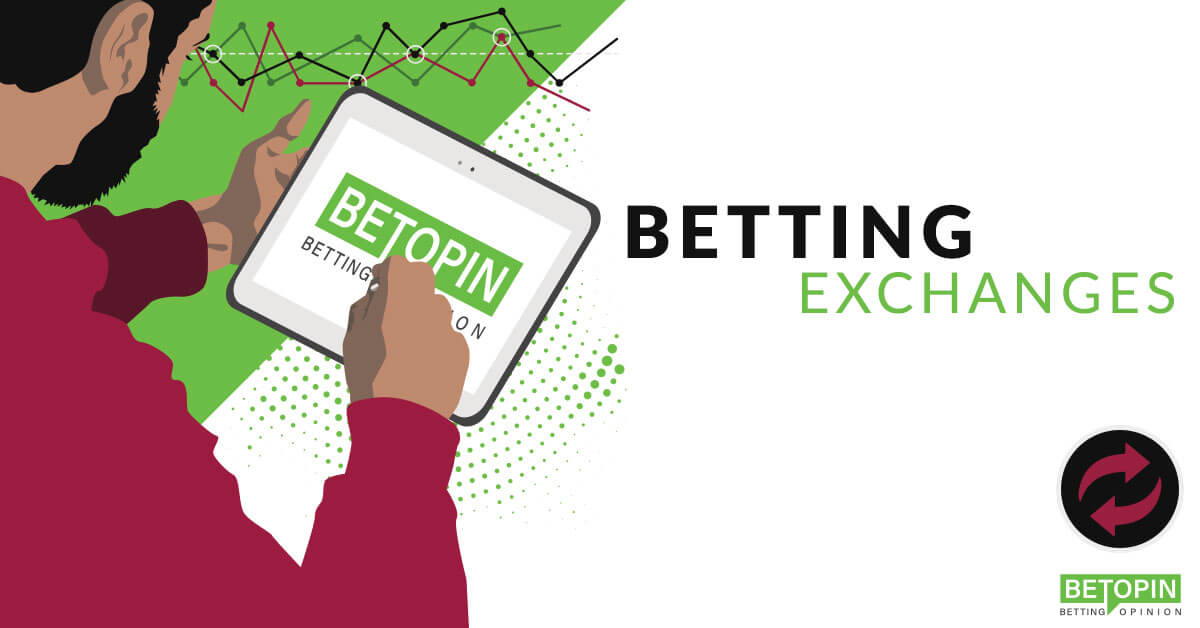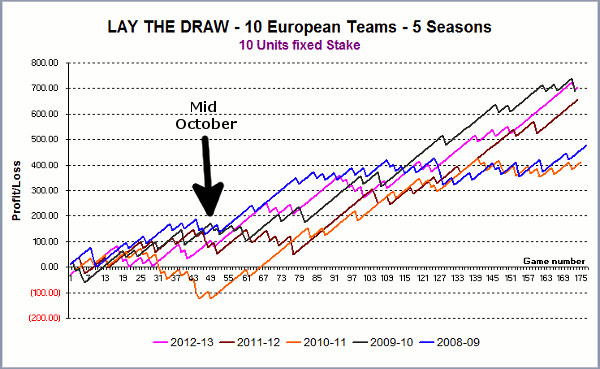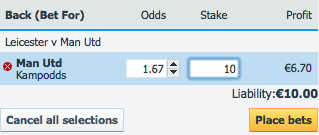How Does Lay Betting Work
Lay betting is an option on exchanges like Betfair where bettors can play the role of the bookmaker and back something not to happen. Punters offer odds to sell a bet instead of to back a bet. It is one component of matched betting, where punters both back. Lay betting is making a bet on an outcome that is not going to happen to win that bet. For example, consider a match between Man City vs Liverpool. Suppose we lay a correct score 1-1, that means we will win the bet if the match does not end at 1-1. So,in this case we will win the bet if.
- The odds you will see in the pink column of the market view, the Lay price, is the price that someone wants to place a Back bet at but is yet to be matched (more on matched bets later). You can take this offer straight away rather than putting your own odds up.
- In matched betting, every bet you place will need to be laid off. You do this using a matched betting calculator, and you lay off every bet so that you never lose any (or much) money on each bet; usually it’s just a few pence. By laying off bets, you can qualify yourself for free bets with very, very minimal investment up front.
Here are some examples:
- Nature Strip not to win his next race
- Australia not to beat New Zealand in the Bledisloe Cup
- Collingwood Magpies not to win the Grand Final
How Does Sports Betting Work
Essentially, you are offering a price that other people can Back bet with you at.
What do the odds represent?
The odds you will see in the pink column of the market view, the Lay price, is the price that someone wants to place a Back bet at but is yet to be matched (more on matched bets later). You can take this offer straight away rather than putting your own odds up. Alternatively, you can enter your own odds and see if it gets matched later or Lay using the Betfair Starting Price (BSP) which will be matched at the commencement of the given event. If your bet returns a profit, you will be charged a small commission.
Broken down, there are three key components:
- Lay odds – the odds which you are prepared to give someone wanting to place a Back bet.
- Backer’s Stake – the amount you are prepared to let the backer bet with you. This is your potential winnings.
- Liability – (Lay Odds) x (Backer’s Stake) – (Backer’s Stake). This is the amount you are risking.
Here is an example on the AFL:
You don’t think West Coast can win the Premiership and the current Lay odds are $8.00. You enter a stake of $10.00. This means that someone on the other side is placing a $10 BACK bet at odds of $8.00.
In this scenario, your liability is $70, calculated by Lay odds ($8) x backer’s stake ($10) – backer’s stake ($10).

This means that if West Coast don’t win the Premiership, you will make $10 (the backer’s stake). However, If West Coast do win, you lose $70.
Why Lay bet?
Sometimes it can be easier to find a team or horse(s) that won’t win as opposed to finding the winner. In a 14-horse race, there will only be one winner – if you can’t identify that winner it might be easier to find a horse or multiple horses that you know won’t win.
Another benefit of lay betting is the ability to “trade out” of an earlier bet that you may have had or make a “green book” which means to secure a profit regardless of the result. You will learn more about trading further into these tutorials.
Learn how to understand the market view
Now that you know the basics of a Lay bet, it’s time to understand the market view on the Betfair Exchange. It can be overwhelming at first but our simple guide will allow you to navigate it like an expert.
Click the NEXTbutton to progress to market view education or start your Betfair Basics tutorial here.
Next To Jump & Bet Recommendations
Next To Jump
Twitter @Betfair_aus
One of the biggest revolutions brought about by the online betting industry is the ability to back against certain results rather than for them. This is known as lay betting, and means you bet that something won’t happen rather than betting that it will.
Until just over a decade ago the only option was to back a result, which has its limitations for bettors.
Betting exchanges are what changed everything, allowing the punter to effectively become the bookmaker, and these are the destination for anyone that wants to lay a bet.
However, there are certain bets in certain markets that offer the same sort of results, which we will discuss throughout this article.
Betting Exchanges List
On the rest of the page we get into the nitty gritty of what a lay betting site is and how it works, but if you’re just after a quick list of sites that offer this kind of bet then see below:
What is Lay Betting?
Lay betting is betting against a result. If you look at any online bookmaker, they are laying every single bet on their site. It is then up to the punter to decide whether they think a certain outcome will happen, and if they do then they can back it.
This means the bookie is in control because they choose the bets and the odds that accompany them. The only choice for the punter is whether to accept them or not.
Lay Betting Sites
As a quick example, you might want to back a horse to win a race because you have some great inside info. However, you have searched all of the sites and can’t find a price that you are happy with. In the old days that would be tough luck, take it or leave it.
These days, you have another option. You could decide to lay the bet on a betting exchange instead. Even though you think the horse will win, you can set odds against it winning that are better than the bookies are offering (and therefore more likely to be taken up by another punter), but make sure the odds are still profitable for you.
How do Betting Exchanges Work?
The exchanges have been around since circa 2000 and caused quite a stir at the time, giving the punter more power and really shaking up the industry.
An exchange is different from a bookie because you are betting against other bettors instead of a bookmaker. This is called Peer-To-Peer or P2P betting because you are betting against your peers.
The exchanges make their money by taking a small commission from each bet. For example, you might bet £10 on a horse to win a race at 10.00 (9/1). If you win, the exchange will then take around 5% (at most, some take less) of your winnings in commission. So, for this bet the commission would be 5% of your £90 profit, equalling £4.50.
The same thing happens when you lay a bet and win as you are making a profit on it. You won’t pay any commission on losing bets, so the exchange won’t take two lots of commission as each market can only have one winner. So regardless of whether you back or lay on the exchange, you will only pay if you win.
The beauty of the exchange is that you are able to set your own price, and so long as someone else takes that price your bet is on. This is called a match. You aren’t guaranteed a match, but the majority of markets will turn in-play and your price will be available until the market closes (game or race ends). If it still isn’t taken then your stake will be returned. Un-matched bets are usually down to low value odds or poor footfall in the market.
Your Liability
When you lay a bet on the exchange it’s important to know exactly how it works. Unlike when you back a bet, you aren’t entering a stake with returns based on your odds; with a lay bet the maximum you can win is the stake that you enter and the liability that you could pay out is then based on the odds that you set.
In short, the bet could cost you money, so you need to think about your finances ahead of time.
If you look at the image above, we have bet against Napoli to win at odds of 1.74 with a £10 stake. If Napoli does win, then we pay out the liability for this bet, which in this case is £7.40. If Napoli doesn’t win, then we get the backers stake, so here it would be £10 profit.
Liquidity
The next thing we want to talk about is liquidity. This is basically the amount of money that can be staked at a certain price for that market.
From the image above you can see that there are financial figures shown underneath each of the prices. This is the liquidity for that bet and the maximum amount of money staked for that selection at that price. For example, you can see that to lay Napoli at odds of 1.73 there is £295 left at that price. If we want to bet more, we can then move down to 1.74 where there is currently £3409 available.
Liquidity isn’t a massive factor for high profile sporting events such as Arsenal v Napoli. You can see in the top right of that image that over £132,000 has been matched, which is quite high and will get higher.
Liquidity becomes an issue at lower-profile events where less money is being staked. This can make it more difficult to either get the price that you want to back or get a low price to lay given there is less money kicking about. You will find disparity in liquidity at each betting exchange as well, with Betfair having a significantly higher market share than all of their competitors, and exchanges only work if people use them.
What’s neat about the betting exchanges is that you are going to quickly be able to see what sort of bet you place and how it affects each of the selections in your betting market.
Continuing with our Napoli example, on the left of the image above we can see the profit that we will make on each result signified by the red (loss) and green (profit) numbers. This is handy when deciding how much exposure you want to create when laying your bets. It also works great if you decide to back your bets at a later date to lock in a profit.
Alternative Methods
You don’t necessarily have to use the exchanges to lay a bet, you can get creative using regular betting markets, but it might not always be as profitable as the bookie will have worked in their margins. To do this, we are looking at bets that cover all but one result; a good example would be using the Win and Draw markets in football.
Let’s say that we are still looking to lay a Napoli win against Arsenal. We can use the double chance market to select our bets to cover this.
By selecting Arsenal and Draw we can cover the two other betting options that would go head to head with the Napoli win. As you can see, the price is a little higher for this than laying Napoli straight off, at odds of 2.10 compared with 1.73.

So, which works out at better value?
If we staked £10 on the Arsenal and Draw bet on the double chance market, our returns would be £21, with £11 of that being profit.
If we laid this bet at odds of 1.74 for £11, which is the profit that we would be getting from the back bet, then we would have an exposure of £8.03 at odds of 1.73.
So, the best bet would be to lay them on the exchange as we are only risking £8.03 compared with £10 using the traditional sportsbook method, for what is essentially the same bet.

Is the Exchange Always Better Value?

The exchange is likely going to give you better odds than most traditional bookmakers would, yes. This is common knowledge throughout the industry, it’s just that some people get a little overwhelmed by the whole process.
Betting exchanges are actually very simple to use once you get over the learning curve, and they are as transparent in terms of what you need to stake and what might be returned as any traditional bookmaker.
If you are looking to lay bets then the exchange is the way to go. We’ve shown you an example of how you can use a bookmaker to essentially lay a selection, but the opportunities are few and far between, while the exchange offers you the chance to lay thousands of bets every day and at better value, too.
In fact, some of the professional bookmakers even use the likes of Betfair or other betting exchanges to balance their books. For example, if they have too much exposure on a certain bet or market, they will jump into the exchanges to lay or back some of it off to cover their backs.

If registered bookies are using them then you sure as heck should be too.